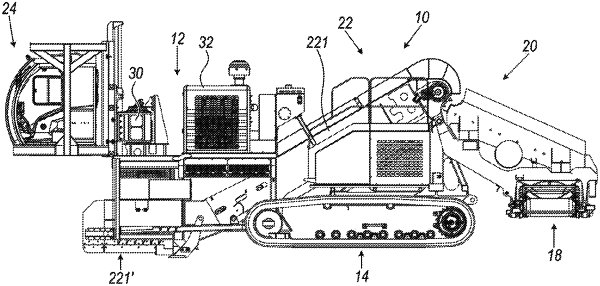| CPC B07B 1/005 (2013.01) [E02F 5/226 (2013.01); E02F 7/02 (2013.01); E02F 7/06 (2013.01); B07B 13/16 (2013.01)] | 16 Claims |

|
1. A padding machine, for burying a pipe and adapted to cover the pipe with a material, comprising:
a main support frame;
a treatment apparatus configured for treating the material including a perforated plate extending from a forward upper portion thereof downward toward a rear of the padding machine;
a lifting apparatus configured for lifting the material above the treatment apparatus, the lifting apparatus including an ascending conveyor belt, extending between a forward lowered part positioned substantially at ground level configured for receiving the material from a collecting apparatus configured for collecting the material, and a rearward raised position higher than the forward upper portion of the treatment apparatus, thereby allowing the material to descend from the lifting apparatus onto the treatment apparatus;
a cabin for housing a driver of the padding machine, the cabin being movable with respect to the main support frame, wherein the cabin is movable to be positionable in a plurality of vertical positions different from each other by vertical movement or movement perpendicular to a ground on which the padding machine sits;
the cabin being centrally positioned with respect to a footprint or transversal extension of said machine to be within a transversal footprint of operating machinery of the padding machine;
wherein the cabin is movable to a lowered transport position, in which the cabin is positioned within a vertical footprint of the padding machine, with an upper wall of the cabin being positioned below an upper end part of a remainder of the padding machine, or of the rearward raised position of the lifting apparatus or of the forward upper portion of the treatment apparatus;
wherein the cabin is movable to a lowered access position for allowing the driver to enter the cabin directly from the ground and to exit the cabin directly to the ground;
wherein the lowered access position is vertically lower than the lowered transport position; and
wherein the lowered access position and the lowered transport position are aligned with respect to each other along a vertical axis.
|